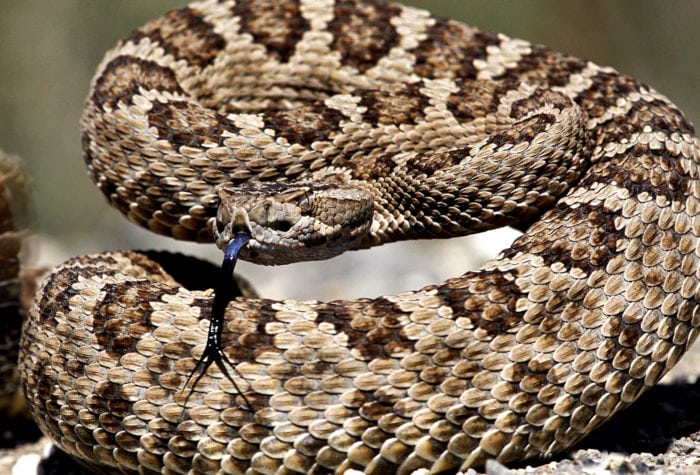This essay was written by Devon Comstock in June of 2010 while she was working for Oregon Natural Desert Association, following a trip into the West Little Owyhee. Special thanks to Jim Davis for unearthing this essay and for providing photos of the trip to accompany it.
It has taken the better part of a day to reach the point where I now stand. It requires a healthy dose of tenacity to enter this canyon, but the rewards are immense…literally. As I look up into the sliver of sky above me, I am hemmed in by up thrusting basalt columns, the color of rust on a cast iron pan. Below me flows a pulsating river, which is abnormally high due to the cool and wet spring we have had this year. Our troupe is comprised of ages 19 to late fifties. I am the only woman and the other half of the only couple in the group. I am glad to have the experience and resourcefulness of the older men and bewildered and amused by the hardiness and energy of the younger men.
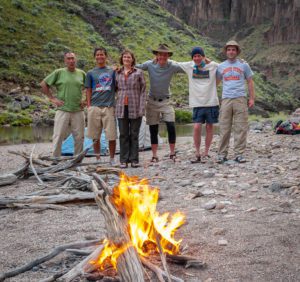 This is virgin territory for me and I would guess that 90% of people I will ever meet have never been here and they never will. This makes this moment even more precious. As we bounced along the boulder fields that pass for roads out here the great plateau stretched out in a seemingly endless blanket of sage, bitterbrush and rabbitbrush. The uplands are lit up by fiery Indian paintbrush, lupine, sulfur buckwheat and globe-mallow. In our last miles we finally begin to see the promise of what lies ahead; the canyon splits open the plateau like a great wound in the earth’s surface. Not a mere cut, but a deep laceration, exposing the flowing veins of water, which feed life into this canyon. I imagine this birth as a violent rendering of the surface. The land has been laid bare for us, to inspect the beating pulse of its heart.
This is virgin territory for me and I would guess that 90% of people I will ever meet have never been here and they never will. This makes this moment even more precious. As we bounced along the boulder fields that pass for roads out here the great plateau stretched out in a seemingly endless blanket of sage, bitterbrush and rabbitbrush. The uplands are lit up by fiery Indian paintbrush, lupine, sulfur buckwheat and globe-mallow. In our last miles we finally begin to see the promise of what lies ahead; the canyon splits open the plateau like a great wound in the earth’s surface. Not a mere cut, but a deep laceration, exposing the flowing veins of water, which feed life into this canyon. I imagine this birth as a violent rendering of the surface. The land has been laid bare for us, to inspect the beating pulse of its heart.
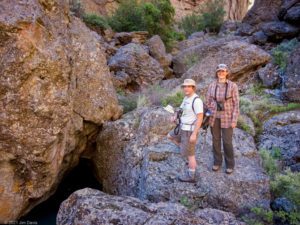 Into these conduits we traverse, down, down, down on an old road grade. It is perhaps 1,500 feet to the canyon floor. As we climb down we pass through the eons, returning back in time. At the floor we find welcoming gravel bars and water-smoothed stones which wrench our ankles and challenge our knees. We cross and recross the river countless time and battle through the willows and chokecherry and are grateful to return to wide gravel bars where the walking is less difficult. As we stop and rest we are privy to the fecundity of this canyon. Each rocky bar hosts at least one killdeer nest and we spy a prairie falcon bringing a snake back to her vociferous den of young. We cross paths with rattlesnakes, gopher snakes, racers, garter snakes and lizards that speed away from us. We spook a mule deer and watch it athletically climb a steep slope.
Into these conduits we traverse, down, down, down on an old road grade. It is perhaps 1,500 feet to the canyon floor. As we climb down we pass through the eons, returning back in time. At the floor we find welcoming gravel bars and water-smoothed stones which wrench our ankles and challenge our knees. We cross and recross the river countless time and battle through the willows and chokecherry and are grateful to return to wide gravel bars where the walking is less difficult. As we stop and rest we are privy to the fecundity of this canyon. Each rocky bar hosts at least one killdeer nest and we spy a prairie falcon bringing a snake back to her vociferous den of young. We cross paths with rattlesnakes, gopher snakes, racers, garter snakes and lizards that speed away from us. We spook a mule deer and watch it athletically climb a steep slope.
There is death here too, we encounter the aftermath of flash floods and find a bighorn ram carcass lodged into a sand bar, with ligaments still intact. We come upon another fresh sheep carcass, still with muscle sheen on it’s bones and hair surrounding it as the flies colonize the last of the moist flesh. We stumble on a coyote den with the remains of a cottontail rabbit waiting to be finished. We find mule deer buck skulls with antlers intact; one is dubbed “Ralph” and becomes a camp mascot for our short stay here. The brevity of life and the persistence of life are evident in each encounter. We too become aware of the tenuousness of our own lives as we hop from boulder to boulder and narrowly miss stepping on rattlesnakes.
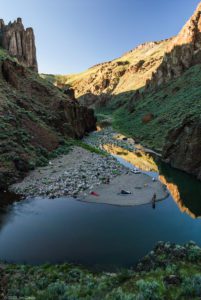 Our journey takes us upstream to a junction with a dry canyon, which rises up from the river like an artery. The canyon floor is littered with the detritus of trees, deposited here by roiling waters swept downriver. As we hike up the dry canyon we find underground springs that create deep pools of milky blue water and perfect reflective reproductions of the basalt outcrops that dominate the sky. We are lacerated by the wild rose and nettles that feed off this subterranean water. They let us know that this is their house and we are guests, so please mind your manners. We tarry through the large boulders, shale fields and thorny jungles. The sun rises higher in the sky crowding out all of the morning shade. We must hunt for overhangs to find respite from the beating rays. The sun finds us like a relentless parent searching for its children, exposing us. The sweat drips from us and our thirst and fatigue grows. We are not adapted to survive here and so must remain visitors. We turn back to the river to refresh ourselves in the cool deep pools of the river, while the hardier members of our party decide to travel further up the canyon.
Our journey takes us upstream to a junction with a dry canyon, which rises up from the river like an artery. The canyon floor is littered with the detritus of trees, deposited here by roiling waters swept downriver. As we hike up the dry canyon we find underground springs that create deep pools of milky blue water and perfect reflective reproductions of the basalt outcrops that dominate the sky. We are lacerated by the wild rose and nettles that feed off this subterranean water. They let us know that this is their house and we are guests, so please mind your manners. We tarry through the large boulders, shale fields and thorny jungles. The sun rises higher in the sky crowding out all of the morning shade. We must hunt for overhangs to find respite from the beating rays. The sun finds us like a relentless parent searching for its children, exposing us. The sweat drips from us and our thirst and fatigue grows. We are not adapted to survive here and so must remain visitors. We turn back to the river to refresh ourselves in the cool deep pools of the river, while the hardier members of our party decide to travel further up the canyon.
We hunker down in the small patches of shade we can find and wait patiently for the sun to draw below the canyon ridge. Our camp is busy with the act of breeding. Across the river from the sandy beach we camp on is a vertical face of basalt where a pair of Brewer’s blackbirds are attentively tending their nest of five. The male acts as a sentinel and the pair are constantly calling and remaining in contact with one another. The female hunts and feeds her brood tirelessly from dawn to dusk. The nestlings bristle with excitement and beg as their mother comes into view, their little red mouths gaping open to receive the insects she brings. She is fastidious in her removal of fecal waste and we are amused to see her drop them into the river with a certain obsessive regularity. This focus is what it takes to survive here. Adjacent to our camp a killdeer guards her vulnerable ground nest. She flaps and screams, feigning injury to keep our focus directed on her. My husband locates the nest holding her four precious eggs and we go out of our way to avoid her during our stay. This is the house of the birds and we are guests here, we must mind our manners.
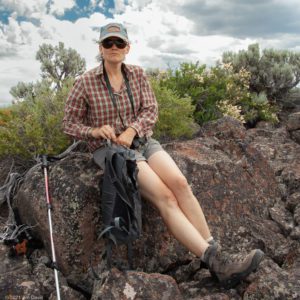 We stay for but a snapshot of time. My husband fishes in the deep pools, I watch the entertaining birds and the shadows on the rocks, others seek to bottle the canyons’ beauty with their cameras, while we all revel in exploring the riffles, pools, caves and ledges. The adventure is heightened by knowing that we are among an elite few who will venture into this canyon and see the sights now laid out before us.
We stay for but a snapshot of time. My husband fishes in the deep pools, I watch the entertaining birds and the shadows on the rocks, others seek to bottle the canyons’ beauty with their cameras, while we all revel in exploring the riffles, pools, caves and ledges. The adventure is heightened by knowing that we are among an elite few who will venture into this canyon and see the sights now laid out before us.
As we ready ourselves to return downriver our bodies have become accustomed to the rhythms the canyon. We have learned not to trust the boulders beneath our feet and watch for snakes in the grass. We have played in the water and slept in the rare shade and warmed ourselves by a fire of driftwood. We have seen no other humans during our stay. We are in a land of solitude, but we are not lonely. The sanctity of isolation is palpable; this canyon holds secrets which should remain untold.
The sky darkens on our last evening bringing with it savage winds that roar like a freight train over the ridge and hit us with a powerful punch. With the wind comes a severe drop in temperature as we awake to near freezing climes. We are ready to leave our generous hosts, they have shared their house with us and given us great gifts. The best we can do in return is to leave it as we found it.
After an arduous journey I return to my home in my city. I wash the desert off my skin and out of my hair, but it has punctured my heart and lodged itself in my veins, traveling with me always.
